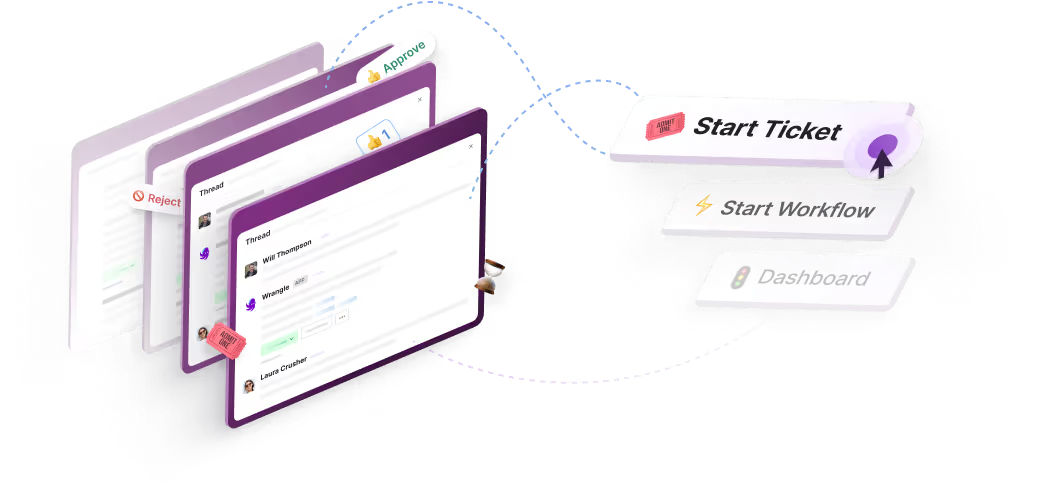The right way to use forms in Slack
Forms are great for logging requests. But what do you do with those requests?


Forms are great for logging requests. But what do you do with those requests?
If your team’s Slack channel has become a deluge of requests from other teams, you might want a form that people can fill out. That way, they provide enough info to explain what they want from your team.
Unfortunately, you’ll soon find that forms aren’t enough.
Sure, forms will fix the immediate problem of people not giving enough context in their request. But now your team has a more important question — how the heck do we track all these requests? How do we make sure someone is assigned to handle them and that they actually get resolved? How do we make sure nothing gets dropped?
It turns out that what you really want is a workflow. A workflow starts with an intake form in Slack but then automatically kicks off a series of tasks and approvals, assigned to your team. That way, you actually manage the request to completion rather than hoping you don’t miss anything in a chaotic Slack channel.
That’s why we built Wrangle, the ultimate tool for managing requests from other teams in Slack.
Let’s review some common situations in which a company would use a form in Slack in the first place. These examples will illustrate why forms often fall short of what you need.
Example #1: Organizing sales quotes
You belong to the sales team, and you’re trying to get a quote from one of your service departments on how long it would take them to fulfill a client’s request. You submit the information via a Slack form, but you don’t hear back from anyone.
Because you don’t have any personal friendships in that department, you consult the company directory to figure out whom you can message directly. You don’t know how often that department monitors the form results, how quickly they assign the information, if they assigned it to the appropriate team member, or if they’ve entered it into a ticketing system to track your request. You submitted this information into a black hole.
You know things are busy for everyone, but it would have been helpful to know the right person received your information—not to mention getting an update on how much longer it would take to build the quote.
Example #2: Launching a marketing campaign
Imagine you’re part of your company’s marketing team that runs Facebook Ads campaigns to advertise your various lines of business. To help other teams ask for a campaign, you created a form in Slack and set it up to ask for the key pieces of information you need to start the campaign: target audience(s), geographic areas, weekly budget, etc.
You make a Slack form and ask your colleagues to submit required information, hoping this will save you from the trouble of having to ask for it in a direct message. Your internal clients fill out the form, and it posts the form data to your team channel. Because your team gets these requests often, maybe you forgot to add this request to a tracking spreadsheet (or assumed a colleague was handling it). As a result, get frustrated DMs from other teams wondering whether you’ll be able to run the campaign they need.
Example #3: Onboarding new employees
You’re a human resource specialist who works with managers to onboard their new employees. To streamline that process, you created a Slack form in which you ask managers to submit the new hire’s names, social security numbers, mailing addresses, and bank account information.
Unfortunately, the managers who fill out the form tend to immediately message you directly after they do so, asking how much longer the onboarding process will take. To their credit, these managers are eager to get their new employees into the company, but this also creates more work for you. You have to spend more time keeping managers updated than you spend acting on their requests.
Even worse, those managers aren’t updated as you onboard the employee. They don’t know the status of the process, and they often get frustrated when they can’t easily get an update from you. They don’t understand that onboarding requires coordinating HR, IT, and finance (both their systems and their people!).
Your Slack form collected the information you needed, but it didn’t reduce the amount of manual work you have to do. It didn’t automatically notify all those other teams that they need to take action, it didn’t track whether those teams were done, and it definitely didn’t keep the hiring manager apprised of updates.
You want a workflow, not just a form
Forms on Slack serve a purpose, but their value is limited. They’re great at collecting information, but they can’t kick off a workflow after the client submits their answers. They don’t assign the request to your team members so they can start the project. And they can’t inform your colleagues of the status of their requests.
You need more than a form. You need a workflow that operates within Slack that keeps your team on track and your colleagues regularly updated.
You need Wrangle. Wrangle lets other teams request help via a form in Slack, then posts the request to your team channel, tagging an assigned member of your team to take action. And it tracks it all in a dashboard so work never falls through the cracks.
Using Wrangle, you can build workflows based on particular needs—reviewing contracts, onboarding new vendors, processing refunds, reporting software bugs, submitting building repair requests, and more. You design the steps in each workflow. You assign the tasks within workflows to particular team members and determine in advance who is responsible for each step in a project.
Your team members are pinged when the workflow is triggered, and your clients are notified as each step in the workflow is completed. Let’s go back to the earlier example of a marketing team collecting information for a Facebook Ads campaign. Here’s how Wrangle could have helped that group complete the project:
- You build a Wrangle workflow and make it available for other people in Slack.
- One of the business line managers clicks to start the Wrangle workflow (right in Slack!).
- Your co-worker fills out the workflow’s intake form, providing context about the campaign they need.
- Wrangle automatically triggers the workflow and notifies the assigned member of your team that they have a new project. Wrangle then notifies the person requesting the campaign that their request has been received and that it has been assigned to a specific person.
- The person assigned on your team can see all the context submitted through the form. They don’t need to schedule additional meetings to clarify the information that was submitted.
- The assignee launches the ad campaign and marks that step as completed on Wrangle.
- Wrangle notifies the person who requested the campaign that it has started. Having received an update, that person doesn’t reach out to you to ask for an update.
- When the ad campaign is finished, your team marks the final step in the Wrangle workflow. The app notifies the person who requested the campaign that their project has run its course.
- Now that the project is over, Wrangle can tell your team how long it took them to complete each step in the process. Your team uses that information to identify bottlenecks and improve its processes.
Wrangle makes all of your form data actionable by routing it to the proper team members. Your colleagues can prioritize their work, and the co-workers who submitted the information to you can be kept up to date every step of the way. By connecting Wrangle to your existing systems via Zapier, you can also update all of your platforms to ensure everyone is working with the best data available.
Even better, Wrangle makes sure that managers like you can see all the work in progress by your team to make sure that no work is dropped or delayed.
Learn More
You don’t have to wait to see how Wrangle can organize your form submissions and improve your workflows. Add Wrangle to Slack to try it out.

- Try Wrangle free for 14 days
- Turn messages into trackable tickets
- Build a scalable help desk



Turn Slack into a productivity powerhouse with Wrangle
Create a scalable helpdesk in Slack. Automatically turn messages into trackable tickets and provide faster, more transparent service to your colleagues and customers with Wrangle — Try it free!






